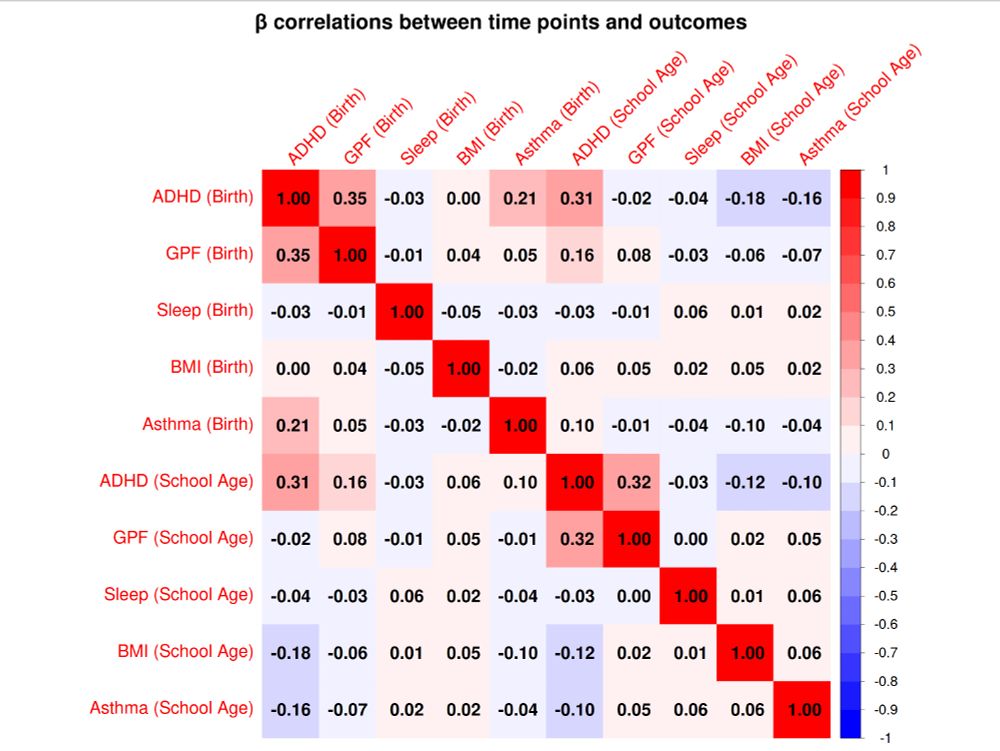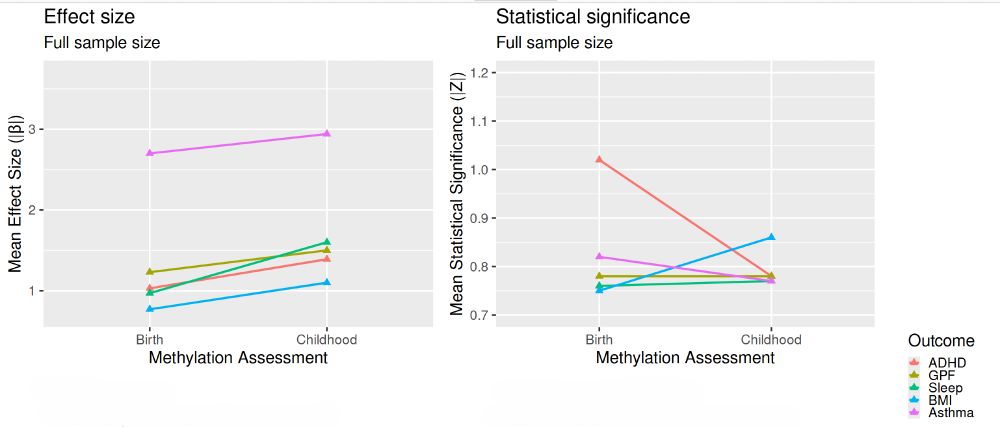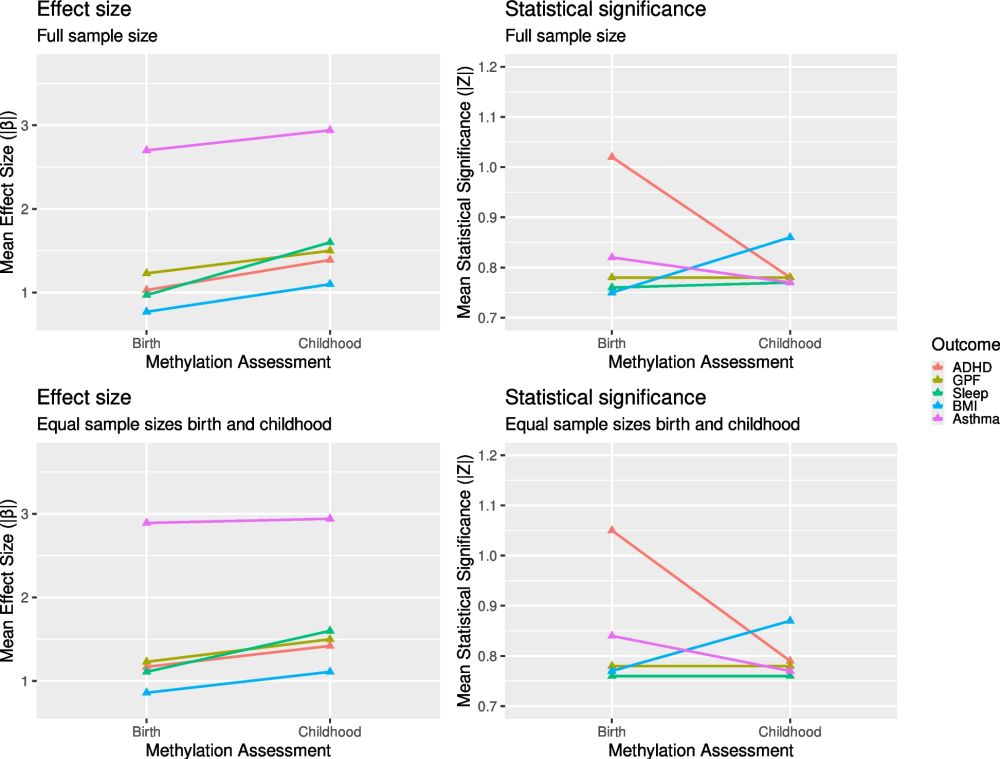Indeed, getting flooded with review request for 2-sample MR papers. To plays devil's advocate: Maybe it's ok/efficient to pump out mindlessly tons of MR papers as long as methods/results are valid? Many are flawed, but many seem scientifically ok, so maybe does not hurt to have it in the literature?
17.05.2025 12:13 — 👍 0 🔁 0 💬 0 📌 0
Thanks to everybody who chimed in!
I arrived at the conclusion that (1) there's a lot of interesting stuff about interactions and (2) the figure I was looking for does not exist.
So, I made it myself! Here's a simple illustration of how to control for confounding in interactions:>
11.05.2025 05:34 — 👍 1135 🔁 276 💬 69 📌 18

Correlations between DNAm effects at birth and childhood and across outcomes. This correlation matrix displays Spearman correlations between regression coefficients for DNAm at birth and childhood and across outcomes. Intensity of red represents higher positive correlations and blue lower negative correlations
What surprised me is how little DNA methylation associations correlated between time points. We found more correlations between different outcomes than between time points. However, a limitation is that this may partly reflect tissue differences (cord blood vs peripheral blood).
05.05.2025 10:07 — 👍 0 🔁 0 💬 0 📌 0

Mean effect sizes and statistical significance for DNAm at birth and in childhood. Mean effect sizes (left column) and mean statistical significance (right column) across all tested autosomal DNAm sites per outcome (color) and timepoint. Effect size is given as absolute regression coefficient (|‾β|), representing the difference in child health outcomes in SD between full or no methylation in the case of continuous outcomes (ADHD, general psychopathology, sleep duration, and BMI), or log(odds ratio) for categorical outcomes (asthma diagnosis). Statistical significance is given as mean absolute Z-values
1. DNA methylation was more strongly associated with child health outcomes when both were measured concurrently in childhood.
2. However, the number of significantly associated DNA methylation sites was not necessarily larger, sometimes even higher when DNA methylation was measured at birth!
05.05.2025 10:07 — 👍 0 🔁 1 💬 1 📌 0
By Raffael Kalisch, Leibniz Institute for Resilience Research (LIR), Mainz, Germany & Neuroimaging Center (NIC), University Medical Center, Mainz, Germany. Research on stress resilience, fear, anxiety, emotion regulation, and mental health
Running in the FAMILY - Understanding and predicting the intergenerational transmission of mental illness.
🔗 https://family-project.eu/
Funded by the EU, SERI & UKRI.
A forerunner in the global landscape of genomics research projects. The study has collected and analysed genome and health data from >500,000 Finnish biobank donors to understand the genetic basis of diseases.
www.finngen.fi
Associate Professor of Data Science & Dean of Research at UVA School of Data Science, #Rstats enthusiast, dad, runner, guitar noise-maker. Views my own.
Web: https://stephenturner.us/
Newsletter: https://blog.stephenturner.us
The Kristel Sleegers lab at VIB Center for Molecular Neurology and University of Antwerp, committed to increase insight in the complex genetics of Alzheimer’s disease.
https://uantwerpen.vib.be/group/KristelSleegers
Postdoctoral researcher at @sleegerslab.bsky.social - VIB CMN working on complex genetics of Alzheimer's. | GWAS, molecular QTLs, TWAS, splicing, long reads, rare variants.
Research Group Leader MPRG Biosocial | Max Planck Institute for Human Development | Jacobs Foundation Fellow
Postdoctoral researcher at the Institute for Molecular Medicine Finland (FIMM), HiLIFE, University of Helsinki. @fimm-uh.bsky.social
European Research Council, set up by the EU, funds top researchers of any nationality, helping them pursue great ideas at the frontiers of knowledge. #HorizonEU
Canadian epidemiologist and causal inference person at Erasmus Medical Center. Big fan of Northern Expsoure and Car Talk.
jeremylabrecque.org
Statistical geneticist. Associate Prof at Dana-Farber / Harvard Medical School.
www.gusevlab.org
Psychologist, researcher in psychiatric genetics 🧠 🧬 at Hospital Vall d'Hebron, Barcelona. Humor, science and horror movies lover.
Child and Adolescence Psychiatrist PhD candidate at Generation R, @ErasmusMC Marie Sklodowska-Curie ESR Fellow @Serotonin_h2020
R, data, 🐕, 🍸, 🌈. He/him.
genetic epidemiologist, mum of twins, rose gardener, occasional expression of an opinion
Professor of Genetic Epidemiology, University of Bristol at: uob-ieu@bsky.social
Research fellow at UCL
interested in developmental psych, quant methods, statistical genetics
Complex Trait Genetics | Population Genetics | Evolutionary Genetics
https://scholar.google.nl/citations?user=hsyseKEAAAAJ&hl=en
Associate Prof Leiden Uni. Studying mental health problems as systems. http://eiko-fried.com. Building an early warning system for depression at http://WARN-D.com.


